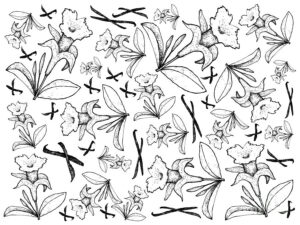Vanilla: A Process


Every year, somewhere between 1,000 and 2,000 tons of vanilla is produced in Madagascar, accounting for the lion’s share of the global market. Cultivating, harvesting and processing vanilla is a labour-intensive job and takes a lot of time until the final product is reached.
Vanilla pods are actually dried berries that grow on the vanilla orchid, a climbing vine that can grow up to more than 15 meters in length. It is the second most expensive spice in the world after saffron and for good reason. First and foremost, growing vanilla is not that simple. Most plants are cuttings and it takes two to three years for a plant to mature and produce berries. The plants are trimmed and led back down so that it remains practicable to harvest the berries afterwards. In Madagascar the plants are pollinated by hand as there are no insects locally that do this naturally. The flowers only stay open for one day, which means that you have to pollinate the flowers in a very organized way!
Nine months later, the berries, which now look like green beans, are ready to be harvested. It is of utmost importance to harvest the beans at the right time, not too early and not too late. The time varies by location. In our region, the ‘green season’ starts around July 15. The beans are now dark green with a color change at the tips (light green to yellow). Only experienced growers are suitable for harvesting the berries. If the beans are picked too early, you will get an inferior product with less aroma. If they are picked too late, you run the risk that they can split open during the drying process. At this point, the beans have no aroma yet and must now be processed as quickly as possible.
After harvesting, the beans are heated briefly and are then alternately placed outside in the sun and shade for several months to dry. At night they are rolled in blankets and kept in an airtight environment to preserve the aroma. During the day you start to smell the dominant vanilla scent after a few weeks on the streets in the villages and towns around the Vanilla Coast. With a perfect moisture level of 28 to 30 percent, the bean can achieve its ideal aroma and eventually find its way as an ingredient in one of the many applications.
When the beans are sufficiently dried, they are packed according to size in bundles with roasted raffia to avoid any humidity in the packaging material. The beans are then carefully placed in wax paper boxes and it is crucial that they have enough space to get enough air. Remember that when you buy our vanilla, you also store it as good as possible. If you use a vacuum sealer, it is important to use a good sealer and this with the correct settings. Please contact us at time of purchase to request the best techniques possible. Usually using glass or plastic jars with a plastic lid is more than ok. Amounts of one kg with sufficient breathing space at the top are best. With cans you can even store up to five kilos.
Our advice is to go for jars or cans and keep them in a dark, dry place. Avoid moisture and do not place it in the refrigerator. We are not a big fan of vacuum packaging. If you use plastic tubes to nicely present the beans, then preferably go for a plastic closure. A cork looks nice, but is less ideal for keeping moisture out. It is therefore of the utmost importance to keep the vanilla away from moisture in order to prevent loss of taste and possible mold. If you pack and store everything correctly, you can keep the vanilla for years without loss of quality.
We ship our vanilla wrapped in plastic and then in a cardboard box in quantities up to 25 kilos, including the necessary export documents.

